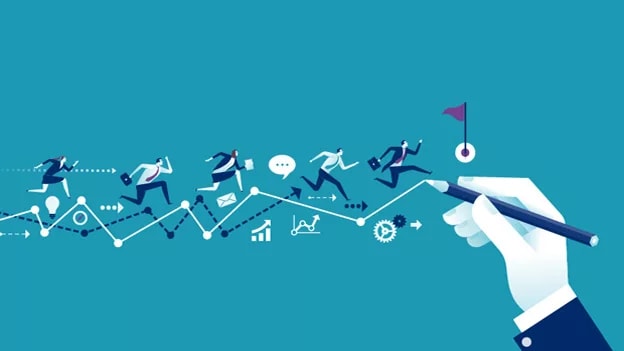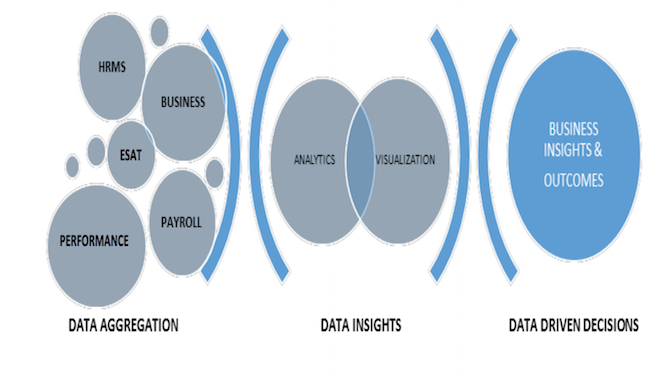Re-imagining HR: Driving business results through people analytics

The last decade has witnessed a hectic explosion of data and source repositories across all domains and spaces: physical and Cloud. But beyond just growth of this data; it is the dynamic data-based interpretation, underlying meaning, and insights derived from this data that will present both the real challenge and the real opportunity for HR and the wider business.
HR teams need to understand the scale of the data being produced as well as the speed at which it is being created and the range of data points from which that data will emerge. This data explosion is what presents a unique opportunity for HR to reinvent and reposition itself.
As global workforce demographics trends shift tectonically and as the war for talent intensifies, the need for HR to reimagine itself and provide a competitive advantage to organizations is being felt like never before. But how do HR functions and teams deliver such sustainable competitive advantages to organizations? How do HR professionals and teams leverage this data explosion to cull out compelling insights that enable sharper decision making triggering higher shareholder value? How do HR professionals equip themselves with the capability to view, interpret and analyze people and business data for delivering compelling insights to their business stakeholders towards driving growth and profitability? How will HR build a compelling case for directly impacting organizational outcomes in a digital and VUCA age?
A single employee view
People Data typically is fragmented across multiple source systems. For example, payroll data in the payroll system, employee data in HRMS, attendance data in a legacy system, training data in some Learning management system, etc; thereby making it almost impossible for the leadership to get a single employee view. Further, the business KPI data is almost in all cases captured in systems that don’t talk to the people data. Teams of excel using analysts spend much of their time reconciling data across these systems trying to make sense of it and by the time they see some light, the underlying data has already changed as the data is dynamic and transforms rapidly in real time.
Imagine if you could bring all relevant workforce-related data together in one place and further enhance it by including connected external data sets or combining it with other systems within your organization. If you could get real insights into the correlations between the data and understand what the implications would be if you specifically focused on improving employee engagement for example, or changing how you reward and recognize your people.
Making a difference to business
People Analytics can make a difference, as it is able to create a single view of all relevant workforce and talent data and use it to arrive at business driving processes and initiatives. Whether it is to analyze employee turnover or optimize the talent supply chain, analytics provides the big picture that decision makers need to improve and align their talent. Instead of just compiling data into monthly reports that might well be just skimmed over, companies must find a way to use their people-related data to positively impact their business. It is through analytics that business linkages could be established from various HR interventions.
Integrating people analytics within the overall analytics strategy of an organization will deliver tangible business results, and improve productivity, profitability, and performance. Its success lies first and foremost in it receiving the complete and committed support of all business leaders across the organization. It is also important to align people data with business data and ensure that business managers not only have access to people data but that they also know how to use it effectively.
The journey from gut and intuition to analytics and insights and then to prediction is with the objective of driving business outcomes. Analytics is to be leveraged to manage risk, enhance productivity, optimize cost, maximize revenue and manage transformation ultimately with a view to impacting growth and profitability.
Finally, it’s important that actual business impact be documented. It’s not enough to use people data to make predictions. What must be done is a periodic follow up to show which predictions came true. More importantly, HR leaders need to understand that there is an ROI for almost everything they do- and they need to compute it all!
Transforming mindsets
There is a critical need to transform mindsets; compartmentalized approaches with silo thinking have predominated both HRM curriculum and practice and there is an urgent need to shatter them and explore a more holistic paradigm facilitated by new HR technology, approaches, and frameworks; at the heart of which is Analytics.
How well do organizations truly understand what drives performance among their workforce? The answer: not really very well. Do we know why one salesperson outperforms his/her peers? Do we understand why certain leaders thrive and others burn out? Can we accurately predict whether a candidate will really perform well in our organization?
The answer to most of these questions is “No.” The vast majority of hiring, management, promotion, and rewards decisions have traditionally been made on gut feel & intuition, personal experience and corporate belief systems. It’s no longer an optimal way to make decisions and yes, while mindsets are changing and data evidencing is being leveraged to a greater extent with assessments and predictive modeling emerging as key focus areas; this change needs to be accelerated.
HR has to be re-imagined and as part of this re-imagination, new cutting edge tools, analytics and visualization technologies, predictive modelling, data science; hitherto never part of traditional HR lexicon; need to be deployed to interpret the gigabytes of data being generated, to throw up patterns and predict behavior, trends and events thereby enabling proactive management action and faster, more agile & optimized real-time decision making.
Getting your people data to talk

















